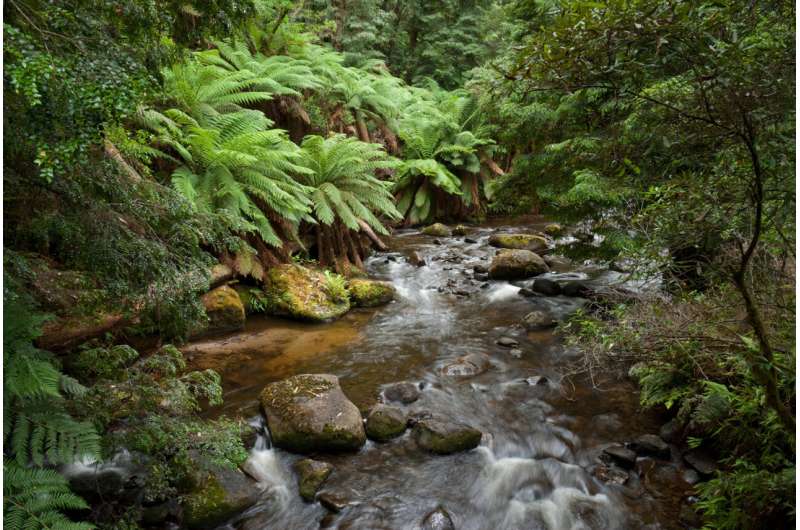Taggerty River flowing through wet sclerophyll forest near Marysville, Victoria. Credit: Ashley Whitworth.
While the post-2020 Global Biodiversity Framework is under negotiation at Montreal's COP15 meeting this week, the Royal Society of Victoria has released its own Report for Changemakers to guide ecological recovery closer to home.
The paper summarizes the current state of biodiversity reviews, responses and policies in Victoria, placed in the broader Australian and global context. It seeks to establish a cross-sectoral position through consensus building, with prioritized recommendations for effective investment strategies and actions by business, government, research and the community, including Traditional Owners and other groups, to help Victorians resolve the biodiversity crisis.
"This is a fast-moving area of concern," says RSV CEO and report co-author, Mike Flattley. "Working out how the legislation and policy works at the Commonwealth and State level is one thing, but then there's all the reviews, inquiries, and strategies to take in."
"Our main aim was to chart this landscape to help other people come up to speed with how matters are progressing in Victoria. Even as we were drafting the report, a federal and state election came and went, new policies and initiatives were announced, and we would have to go back to the drawing board. To be honest, after so many decades of lackluster effort by State and Commonwealth Governments, it's really great to see so much activity on addressing biodiversity loss, even if it hasn't all really joined up properly yet."
"Joining things up" is the main concern of the Society's paper, which follows an intersectoral forum involving representatives from First Nations, the research sector, the finance sector, government and community advocates held back in June 2022. The forum raised a range of priorities and interventions to help our complex, highly sectioned system of society better align with the complex, relational system of biological diversity in Victoria, all of which are explored and clarified in the report.
"The main thing for everyone to be aware of is that the looming extinction crisis is everyone's problem," says RSV President Rob Gell AM. "It's no good sitting back waiting for somebody else to deal with it. Governments, industries, communities, academics, First Nations—we all have a responsibility, and a role to play. The challenge comes from knowing exactly which role is yours, how it relates to the roles of others, and how to coordinate the collective effort across different sectors, institutions and regions."
"This is particularly important when there's not much funding on the table to address the status of our threatened species."
Which is the point of the entire exercise. The report sets a grim prospect for Australia, where more than 1,800 native Australian species and ecosystems are threatened with extinction. Our nation is losing more biodiversity than any other developed country, with the extinction of over 100 native species since European colonization formally recognized under Commonwealth legislation. With over half of its land area cleared since European settlement, the State of Victoria leads the pack—accounting for the lion's share of species already lost, and those on the brink.
Victoria's Commissioner for Environmental Sustainability's State of the Environment 2018 report states that a third of all of Victoria's terrestrial plants, birds, reptiles, amphibians, mammals, invertebrates and ecological communities are currently threatened with extinction, and the next report due in 2023 will further account for the impacts of the Black Summer bushfires of 2019-20. Tall mountain ash forests and snowpatch herbfields in the Victorian Alps are at direct risk from climate change and invasive species, while the vast Great Southern Reef giant kelp forests are suffering from the impacts of coastal development and pollution, ocean acidification and heating, overfishing, the spread of invasive organisms and increased storm frequency and severity. In short, it's not good.
The solution presented by the Society seems blindingly obvious: we must transition from a net extractive to an additive, reciprocal relationship with the natural world, investing more while destroying less. In practice, this requires serious investment and considerable cultural change—which are diabolically difficult to secure.
The Royal Society of Victoria has recommended the following actions:
- Recognize First Nations' Leadership in Ecological Management
- Resource Local Ownership & Leadership of Restoration Ecology Projects
- Appoint an Independent Regulator to Govern Biodiversity Values in Victoria
- Establish Funding Diversity for an Intersectoral Nature Fund
- Build Effective Investment Instruments for the Business Sector
- Create an Independent, Intersectoral Taskforce for Biodiversity Recovery and Conservation in Victoria
The measures detailed under each action are variously instrumental, economic and cultural in nature, demonstrating the need to activate a social science frame to better translate the "hard sciences" into tractable actions. The recommendations were developed through reference to the expertise held by four Fellows of the Royal Society of Victoria, appointed in 2022 from four sectors of society; Ms. Fern Hames (Government); Mr. Damein Bell (Community & First Nations); Ms. Judith Downes (Industry); and Professor Brendan Wintle (Academia).
"It's no good for any one tribe to just be talking to itself about the big problems facing society," according to Mike Flattley. "It's too easy to push the problem downstream to another sector. It's the government's problem. It's industry's problem. Wrong. It's everyone's problem, so the solutions we identify need to make sense to everyone."
"By bringing highly principled, intelligent people together from across our culture, we get an opportunity to make the science clear to everyone, then develop ideas that are owned by people working across the board. By collaborating, we get to understand each other's roles and responsibilities, and also to hold each other accountable with due respect for our limitations. And by maintaining the peer review process, we keep the process scientifically robust."
The Royal Society of Victoria's Report for Changemakers, with attendant summaries, is available from their website at rsv.org.au/biodiversity-recovery/.
More information: Towards Conservation & Recovery of Victoria's Biodiversity—Report for Changemakers: rsv.org.au/biodiversity-recovery/
Provided by The Royal Society of Victoria
























